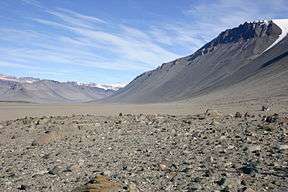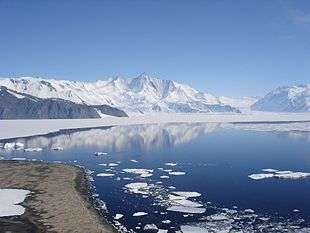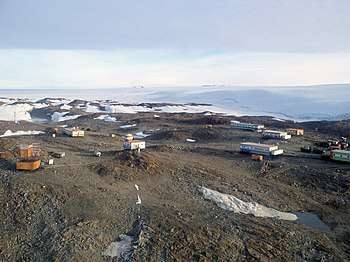Antarctic oasis
An Antarctic oasis is a large area naturally free of snow and ice in the otherwise ice-covered continent of Antarctica.




Geology
In Antarctica there are, in addition to mountain tops and nunataks, other natural snow- and ice-free areas often referred to as "Antarctic oasis" or "dry valleys".[1][2] These areas are surrounded by the Antarctic ice sheet or in coastal areas situated between the ice sheet and the Antarctic ice shelves.
Antarctic oases and dry valleys develop in areas with particular regional weather patterns and geography. These areas have very low humidity and precipitation. Although these areas are very cold, sufficient solar energy is absorbed by the ground to melt what little snow does fall, or else it is scoured or sublimated by katabatic winds leaving the underlying rock exposed.
Despite usually extreme aridity, some plants, in the form of bryophytes and lichens, can survive in Antarctic oases.
Geography
The larger oases are:
- McMurdo Dry Valleys, about 4,900 km2 (1,900 sq mi), Victoria Land
- Cape Hallett, northern Victoria Land
- Bunger Hills, about 950 km2 (370 sq mi), between Wilkes Land and Queen Mary Land
- Holme Bay, Mac. Robertson Land
- Vestfold Hills, about 420 km2 (160 sq mi), Princess Elizabeth Land
- Larsemann Hills, Princess Elizabeth Land
- Stillwell Hills, about 96 km2 (37 sq mi), Kemp Land
- Schirmacher Oasis, about 34 km2 (13 sq mi), Princess Astrid Coast, Queen Maud Land
References
- Riffenburgh, Beau Encyclopedia of the Antarctic, vol II (Routledge, New York, 2007, ISBN 0-415-97024-5)
- http://iopscience.iop.org/1755-1315/1/1/012035/pdf/ees8_1_012035.pdf, IOP science, accessdate=2010-11-22
- Bernadette Hince, "The Antarctic dictionary: a complete guide to Antarctic English", 2000, Csiro Publishing, Collingwood, Australia, ISBN 0-9577471-1-X, accessdate=2010-11-22
Further reading